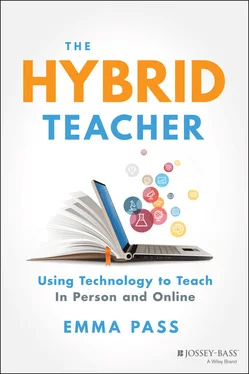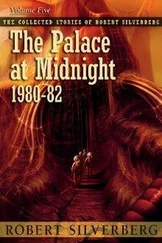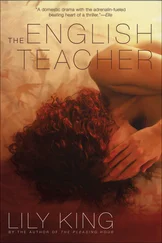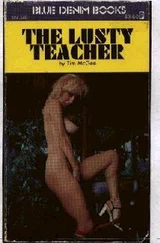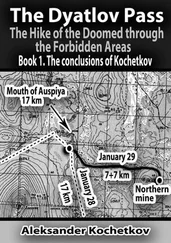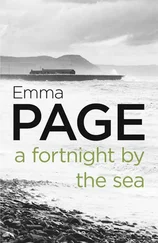
Before We Begin
HOW TO USE THIS BOOK (PRINT)
I am an English teacher and therefore love physical, paper books. I love to hold them, smell them, gaze upon them as they sit peacefully upon my bookshelf. However, this is a book about technology, and technology is fast paced, flexible, and alive.
Nearly every page of this book has a live link for you to explore, which is very hard to do on paper, which is why I've created an interactive webpage to accompany this book that you can access at hybridteacherresource.com. The links are also available on this book's page on www.wiley.com.
I recommend you highlight, underline, and annotate galore in the print version, and when you get to a link you want to explore, visit the webpage on your computer to find and follow the link. They should be easy to find as they are organized in the same chapter and subsection headings.
Then, be sure to bookmark your favorite tools to use later!
As I mentioned, this book is chock full of links to educational technology (EdTech) resources. Often I see myself as less of a writer and more of a librarian or curator of EdTech tools, and this book is a collection of my current favorites.
Because the people who make these tools often do it as a means of employment, most tools have some premium version that you can buy to unlock additional features or products.
However, because I am myself a teacher and know all too well the reality of teaching without a classroom budget and spending out of pocket, EVERY tool I mention in this book has a FREE version. In fact, almost every tool I use in my own classroom is the free version.
If you have a sizable classroom budget, why not upgrade and support the education technology industry? If you have a sizable heart and pockets, consider donating to Donors Choose ( www.donorschoose.org) to help other teachers upgrade as well.
Disclaimer: I am not sponsored or paid by any of these companies to promote their products.
These terms will help provide a foundational understanding for the content that follows.
| Hybrid Learning |
Refers to the place learning happens; in person and online. |
| Blended Learning |
Refers to the tools used to conduct learning; a combination of traditional tools (i.e. books) and online tools (i.e. laptops, videos, EdTech). |
| Online Learning |
Education that takes place entirely online. |
| Learning Management System (LMS) |
An online platform for the facilitation of learning. Most notably the distribution and collection of student work. |
| Video Conferencing |
An online platform where multiple people can join a call via video voice, video, or both. |
| Synchronous Learning |
Teaching and learning occurs together, simultaneously. |
| Asynchronous Learning |
Students access learning at different times and work through it at their own pace. |
| Browser |
An application that allows you to access the internet. Chrome, Firefox, and Safari are examples. |
| Chrome Extension |
Small software programs that give you additional features on any given website within your Chrome web browser. |
| Add-On |
The “add-ons” I refer to in this book are specific to Google files such as docs, slides, and sheets. Add-ons are downloaded to your Doc, Slide, or Sheet and provide advanced functionalities. |
| App |
A computer program that needs to be downloaded to your device (most often a phone or tablet). |
| Hyperlink |
Similar to an address, a hyperlink directs you to a website or web-based document. |
Far and away the best prize that life offers is the chance to work hard at work worth doing .
—Theodore Roosevelt
Before I start teaching a new unit, I always try to address the “Why?” with my students. Why are we learning about this? Why will it be meaningful to you? Why will it be beneficial to your life?
For this book, I've not only asked myself the “why?” but a few more Ws too. Here is what I've come up with:
What: This is a book about using technology and online pedagogy to enhance teaching and learning as a whole.
Who is it for: K-12 teachers of all content areas, in brick-and-mortar, remote, and hybrid schools.
How might it be used:
1 Emergency Preparedness I was approached to write this book in the height of the COVID-19 pandemic, when millions of schools globally shut their doors in order to reduce the transmission of disease and save lives.When it comes to safety, schools regularly prepare and practice for emergency scenarios. I imagine schools will now begin to adopt and regularly practice “emergency remote learning” to be prepared for future disease outbreaks, natural disasters, or any other number of unforeseen circumstances.This is a guide for them.
2 Emerging Hybrid School ModelsAlthough many teachers, students, parents, and administrators (rightfully) struggled with adapting to emergency remote or hybrid learning during the COVID-19 pandemic, I hope some innovative educators were able to see beyond the struggle to the benefits of hybrid learning for certain student populations, and new hybrid schools models will begin emerging in districts across the country.This is a guide for them.
3 Educational Technology Benefits EveryoneIn a 2016 Arizona State University study on educational technology (EdTech), researchers found that the use of EdTech in teaching and learning “can have considerable positive impacts on student performance, and efforts to adopt new educational technologies in the classroom will be rewarded.”Although this book is focused on teaching in a hybrid model, the tools and techniques can be applied to most learning environments.The study also found that the biggest barrier to success in the implementation of EdTech is providing teachers with the necessary professional development.This is a guide for you.
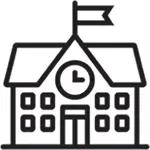
Bring it back to the building
If you teach full time in a “brick-and-mortar” classroom, look for these sections, where I explain how an online tool, resource, or strategy could be used in a traditional classroom model.
My first teaching job was as a 6th-grade English teacher in Las Vegas, Nevada.
My years there were easily the most challenging and rewarding of my life. My love for those first students of mine resonates throughout my entire body. My students came from the most diverse (in the true sense of the word) backgrounds imaginable. They were Black, White, Latinx, European, African, and Asian. They were the children of wealthy surgeons as well as single parents who worked the night shift at Burger King. Some of my students had boats that they would take out on Lake Mead, while others were homeless. Our school was a magnet school for the deaf and hard of hearing, and we had a number of students who were Syrian refugees.
Meeting the needs of such a diverse and large group (I taught nearly 200 students per year) was an impossible task. However, I thank my lucky stars every day that our school was awarded a grant in my first year of teaching to receive 1-1 Chromebook devices. (Meaning each student had access to their own device that they were able to use in school and take home.)
Читать дальше
